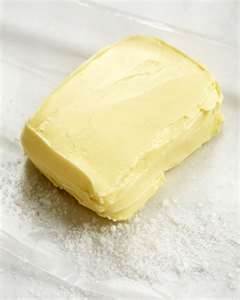 Butter is a highly concentrated form of milk that contains protein, calcium and phosphorous, and the fat-soluble vitamins A, D and E. It is produced by churning whole milk or straight cream until butter fats form and separate from the water-based components of the cream. Approximately five gallons of whole milk or cream yield just over two pounds of butter. In North America, butters hover between 80% – 82% milk fat, whereas European butters are typically between 82% – 84%. The rest of it is mostly water (more later on the importance of water content) and a few milk solids. Salted butters have salt added, of course, typically in concentrations of 1% – 2%. There’s a lot of chemistry to butter, but we’ll skip the composition details for the moment and move next to explaining how U.S. butters differ from European butters. And of course, why French (Breton) butter tastes bestest of all.
Butter is a highly concentrated form of milk that contains protein, calcium and phosphorous, and the fat-soluble vitamins A, D and E. It is produced by churning whole milk or straight cream until butter fats form and separate from the water-based components of the cream. Approximately five gallons of whole milk or cream yield just over two pounds of butter. In North America, butters hover between 80% – 82% milk fat, whereas European butters are typically between 82% – 84%. The rest of it is mostly water (more later on the importance of water content) and a few milk solids. Salted butters have salt added, of course, typically in concentrations of 1% – 2%. There’s a lot of chemistry to butter, but we’ll skip the composition details for the moment and move next to explaining how U.S. butters differ from European butters. And of course, why French (Breton) butter tastes bestest of all.
N.B. Let the record show that an agent of one of France’s neighboring states has launched a formal challenge to my claim of French butter superiority. Stay tuned for…The Butter Wars.

Ha!
love this…
I am curious. So butter is milk churned until the fat separates from the milk. What happens to the rest of the milk, is it tossed or turned into another product?
And, what about Naomi?
I’m with you on the superiority of European butter. I used to buy Plugra (European style butter) at Trader Joe’s which right now, is not available. Looking forward to reading the rest of your comments.